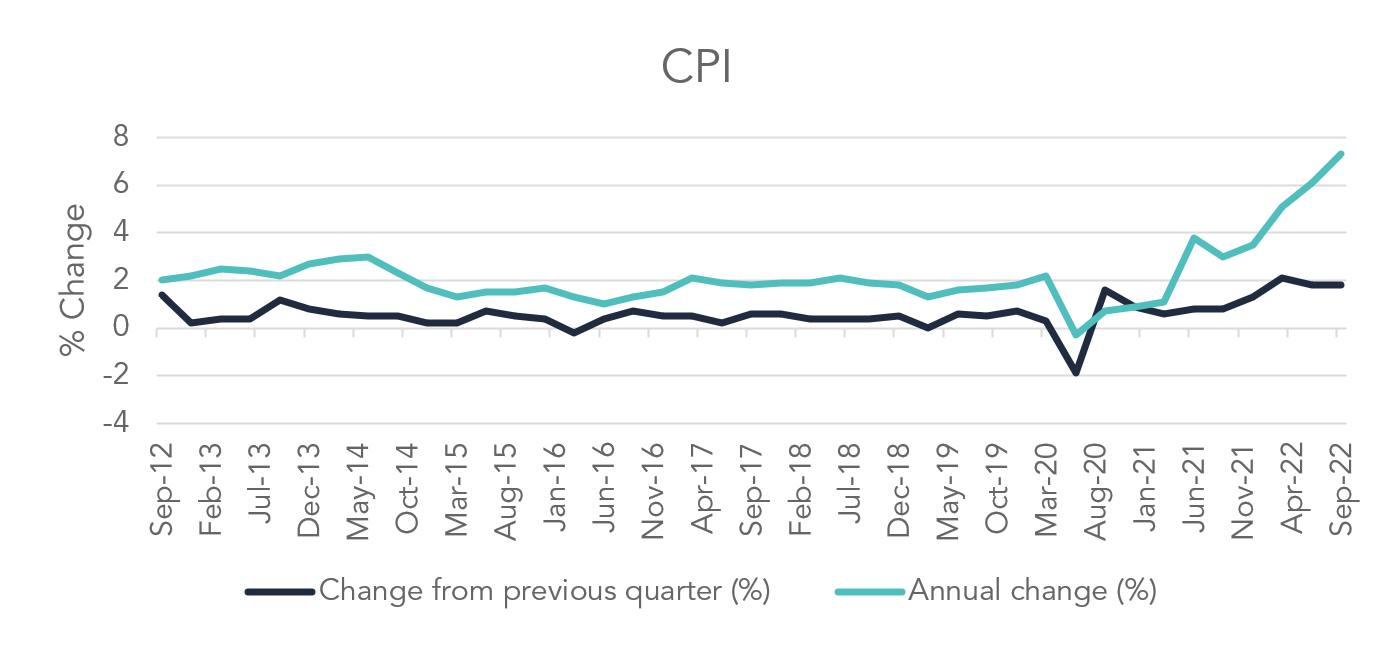Where to from here? What the Shiller PE and Buffet Indicator are telling us
It has been a big month with bank runs leading to bank collapses, the bailout of Credit Suisse and fresh short-seller attacks on Deutsche Bank.
The Treasurer delivered the Federal Budget a day before the Australian Bureau of Statistics confirmed that inflation is still on the rise.

This week, the Treasurer delivered the Federal Budget a day before the Australian Bureau of Statistics confirmed our expectations that inflation is still on the rise.
The consensus view of the investment team was that the Federal Budget on the whole was conservative and responsible given the economic conditions we are currently experiencing and the degree of uncertainty that lies ahead. The Australian economy has demonstrated relative resiliency against the backdrop of a global pandemic, natural disasters and global volatility driven by geopolitical issues. Ongoing concerns around inflation remain at the forefront, with rising interest rates and an expected global economic contraction yet to come.
It should be noted that the IMF and Treasury forecasts do not show Australia entering a recession. The labour market is tight as we are facing skill shortages and falling real wages. The years of COVID-19 driving monetary and fiscal policy support is now over, with the government focused on repairing the Federal coffers.
The budget was built upon adjusted economic forecasted figures, the key ones being:
Economic growth – expected to be 3.25% in 2022-23 (a slight decrease from the 3.5% forecast made in March) before dropping to 1.5% in 2023-24 (a significant revision from the previously forecasted 2.5%);
Unemployment rate – expected to fall to 3.75% over next 2 years; and
Wages growth – currently 2.6% and expected to grow to 3% - 3.75% over the next 4 years. With inflation continuing to rise, Australians will not be getting a real pay rise for around 12 months.
Despite soaring prices and a tight labour market, Australia’s economic growth is cooling:
The 2021-22 net deficit was $32bn ($48bn lower than the March forecast) and is expected to rise to $36.9bn in 2022-23.
Net debt is expected to reach $572.2bn in 2022-23 (down on the March forecast of $714.9bn).
Net debt is expected to reach $766.8bn in 2025-26 (down on the March forecast of $864.7bn).
The reductions reported in debt and deficit are driven in part by higher commodity prices (expected to moderate over time) which have boosted Australia’s national income, lower unemployment and $22bn in spending cuts. As economic growth is expected to cool, net debt as a percentage of the Australian Gross Domestic Product is expected to increase and peak at 28.5% in 2025-26.
At a high level, the budget’s areas of focus were:
New National Housing Accord between government, investors and industry to build more affordable housing and aim to build 1 million new homes over 5 years from 2024.
Paid parental leave expanding to 6 months by 2026 accounting for $530m.
Cheaper childcare with $4.7bn in funding over 4 years.
Cheaper medicine from 1 January 2023.
Defence funding rose 8% in 2022-23 to more than 2% of GDP over the next 4 years
Aid funding rise to $1.4bn over 4 years
Reduced from $17.9bn in the last budget to $8.1bn, largely to fund rail and road projects
Building additional social and affordable homes in line with the government's election promises
Help to Buy scheme to assist young buyers get into their first homes
Cheaper medicines from 1 January 2023
Covid funding beyond 2022 was denied
Shift to assist urgent care clinics to remove some burden from the public health system
$2.6bn in funding for Covid vaccinations and treatments for people at risk
NDIS additional funding at $166.6bn over 4 years, a $8.8bn rise
TAFE-funded positions for 480,000 fee-free places
20k additional university-funded places over 2 years
10k new energy apprenticeships to train for new jobs and skills in the field
The aim is to assist the small business sector and businesses within the community as they are crying out for more skilled workers
$25bn in climate-related spending through 2030
$20bn government promise to upgrade electricity grid to feed through more additional renewable energy solutions
$275m to encourage the use of electric vehicles
$200m for disaster-ready fund
With this being the Labour Government’s first budget in over a decade, taking a cautious and measured approach seems appropriate. Spending is being attributed to areas that will assist households with inflated everyday costs and bring skilled labour back to our workforce which will assist businesses currently feeling the strain from the very tight labour market. The budget has been designed to address current issues and time will tell as to the efficacy of the annual budget.
Inflation increased in September, up by 1.8% and 7.3% annually. New dwellings rose by 3.7% over the quarter, gas was up 10.9% and furniture was up 6.6%.
The tight labour market is putting continued strain on the construction industry. Ongoing shortages of building materials have also created compounding pricing pressures. Despite these ongoing pricing pressures, we are also beginning to see a drop-off rate in the number of new dwellings, implying that monetary policy intervention is starting to soften new demand which will assist in reducing the supply-side constraints.
The annual review of gas prices revealed that higher wholesale gas prices were largely passed onto consumers in the September quarter. Electricity rose by 3.2% which is much lower than the expected 15.6% thanks to the State Government subsidies handed out in WA, QLD and the ACT. The Federal Budget did not provide households with many concessions in terms of electricity and gas despite the ongoing cost of living pressures. As such, we would expect this to rise in the coming months.
New global and domestic challenges continue to shift the inflationary pain points. Next week’s RBA monetary policy decision will take this inflationary read into account and will assist them in determining the extent to which they raise rates. The RBA has recently indicated that whilst household budgets are beginning to feel the pressure, the way in which household spending will respond remains uncertain. The board will closely monitor the global economy, household spending and price-setting behaviours in order to determine the incremental rate rises they have implied are still yet to come.
The Aura High Yield SME Fund has been recognised as the best-performing Credit Fund in Australia (2nd across the Asia Pacific) for H1 2022 in the Preqin Honour Roll. This follows their recognition as the 2nd best-performing Credit Fund in Australia (4th across the Asia Pacific) for H1 2020.
"The team is pleased to see our investment philosophy and structuring, which prioritises both capital and income stability, perform positively over multiple periods of heightened market volatility," said Portfolio Manager Brett Craig. "Thank you to our investors for entrusting us with your savings throughout this volatile period".
This weekly letter was written by Natalie Kolenda and James Chapman of the Aura Private Credit Team.
Sources:
1 Source: Australian Bureau of Statistics – Weekly Payroll Jobs and Wages in Australia, September 2022
2 Source: Australian Bureau of Statistics – Return of Overseas Migration Spurs Australia’s Population Growth, September 2022
3 Source: ABS – Labour Force, Australia, September 2022
4 Source: Reserve Bank of Australia – Speech; Policymaking at the Reserve Bank
Important information
This information is for accredited, qualified, institutional, wholesale or sophisticated investors only and is provided by Aura Funds Management Pty Ltd (ABN 96 607 158 814, Authorised Representative No. 1233893 of Aura Capital Pty Ltd AFSL No. 366 230, ABN 48 143 700 887). Aura Funds Management Pty Ltd is the Trustee of all the Funds mentioned and a subsidiary of Aura Group Pty Ltd.
Any financial product advice given in this report is of a general nature only. The information has been provided without taking into account the investment objectives, financial situation or needs of any particular investor. Therefore, before acting on the information contained in this report you should seek professional advice and consider whether the information is appropriate in light of your objectives, financial situation and needs. Aura does not guarantee the performance of its funds, the repayment of any capital or any rate of return. Investing in any financial product is subject to investment risk including possible loss. Past performance is not a reliable indicator of future performance. Information in this report is based on the information provided to Aura by third parties that may not have been verified. Aura believes that the information is reliable but does not guarantee its accuracy or completeness. Aura is not able to give tax advice and accordingly, investors should obtain independent advice from an accountant and/or lawyer before making any decision based on the tax treatment of its investors. You must read the Fund Fact Sheet or Information Memorandum and seek professional advice before making a decision to invest in any of the funds.
It has been a big month with bank runs leading to bank collapses, the bailout of Credit Suisse and fresh short-seller attacks on Deutsche Bank.
This week, the Australian Bureau of Statistics released the monthly consumer price index, seeing a slight month-on-month fall
Like onions, blockchains have layers. These layers can almost be viewed as different segments of the industry.
Subscribe to News & Insights to stay up to date with all things Aura Group.